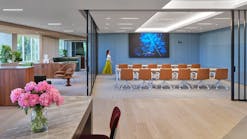In May 2020, I came out as transgender. Based on my observations of the architectural lighting industry over my 15 years of experience, I felt like I was the only one at the time. I felt alone.
I was also struggling with job loss — just as the pandemic was taking hold, no less. Subsequently, I had to figure out how to present myself to potential employers. Do I put my deadname — the name given to transgender people at birth — on my résumé because that’s how the industry knows me? What about interviews? My voice doesn’t pass over the phone. Should I express masculine and mention that I’m starting transition, or should I go full femme? If I go femme, should I bring up the elephant in the room? Should I bring up the liability my gender expression might have to sales in smaller markets? Nobody in the industry seemed to have insight in answering — much less understanding — these questions.
After a few months of positive first interviews followed by complete silence, I attended the virtual LEDucation in August 2020. I hoped to reconnect with colleagues and find job leads. At a panel hosted by Women in Lighting + Design (WILD), speakers shared their struggles seeking work, inclusion, and respect. Their travails sounded similar to what I was experiencing. During the Q&A, I typed a question seeking advice and hovered over “send” for a long time. I never clicked. I didn’t feel like I had the right to steal focus, and I didn’t know whether my presence or voice would be welcomed.
[The NACLIQ] mission is straightforward: to serve as a beacon of visibility and a shelter of strength and support for those most in need in the LGBTQ+ lighting community.
Later that day, I had a long conversation with my friend and WILD president Kelly Roberts. With her encouragement, I resolved to be the change I wanted to see in the world. Within four days, I had a website up for what would become the North American Coalition of Lighting Industry Queers (NACLIQ).
Soon after, we — the royal “we,” of course, as it was only me at this point — were hosting happy hours and participating in virtual panel discussions on issues of diversity, equity, inclusion, and respect, as well as of injustice in lighting and beyond. We had a few regular attendees to the happy hours, but our reach was still small. Finding others willing to commit time and effort to building an organization was difficult, but that changed over time as pandemic restrictions eased. We are now a fully functioning organization on our way to becoming a registered nonprofit.
Our mission is straightforward: to serve as a beacon of visibility and a shelter of strength and support for those most in need in the LGBTQ+ lighting community. We stand for those among us — namely transgender, nonbinary, and intersex people — struggling with employment discrimination as well as a lack of legal protections for housing and accommodations. Initially, our focus was to normalize queer existence in places where people don’t feel safe living their truths, including rep agencies, manufacturers, distributors, and secondary markets in design. It seemed simple. Normalize LGBTQ+ existence in the lighting world beyond the big-city design firms — with an extra dash of trans visibility courtesy of NACLIQ’s founder: me.
Recent developments have brought a sense of urgency to our mission and caused us to retool our approach. In addition to being a beacon and a shelter, NACLIQ has taken on the task of fighting for the fundamental rights of all LGBTQ+ people. This year alone, nearly 240 bills have been introduced in the legislatures of almost every state. This is in addition to the 191 bills introduced last year.
To date, eight states have passed legislation, including Florida’s House Bill 1557, commonly known as the “don’t say gay” bill; Alabama’s one-two punch of Senate Bill 184, criminalizing gender-affirming care for trans kids; and House Bill 322, banning trans kids from gender-aligned bathrooms as well as curtailing classroom discussion of all things nonheteronormative.
The impact these of these measures on the mental health of trans kids and adults compelled to remain closeted in such hostile conditions is unfathomable. Research has found that closeted workers tend to experience degraded mental health and reduced productivity and creativity. Before this onslaught, the transgender population suffered from a 40% suicide-attempt rate before this onslaught — a rate that will only get worse. In short, this is not a political spat over LGBTQ+ rights, but rather a fight for queer existence itself — and a matter of life and death.
And for what? Why persecute us when we could be contributing, thriving, and living our lives to the fullest?
Before I came out, I struggled just to make it through each day. Now that I’m living my truth, I feel supercharged: I founded NACLIQ, started my own business, and even returned to theatrical lighting design after 15 years away as a fun side project.
Business leaders often ask me what LGBTQ+ advocacy has to do with lighting or with their business specifically. It’s simple: queer people engineer your PCBs, issue your quotes, sell your fixtures, and design your projects.
NACLIQ is doing what we can to protect our people so that they too can thrive. We recently wrote an open letter to business and organization leaders in the industry, calling on them to condemn these unwarranted attacks publicly. Several organizations and trade events have responded, including the IES and LightSPEC (which is owned by Endeavor Business Media). However, businesses largely remain silent.
Business leaders often ask me what LGBTQ+ advocacy has to do with lighting or with their business specifically. It’s simple: queer people engineer your PCBs, issue your quotes, sell your fixtures, and design your projects. Your favorite rep might have a husband that he’s never talked about because his boss implied that it would be bad for business. The designer whose project you just “liked” on LinkedIn might be planning on moving out of her home state because she fears criminal prosecution for helping her trans daughter get gender-affirming care. Your nonbinary office manager wishes they could add pronouns to their email signature so they could feel seen and be gendered correctly, but it violates company standards. We’re everywhere regardless of whether you know it.
Efforts to curtail our rights affects an innumerable multitude in the lighting world in a real and profound way. The issue is no less pressing than wage equality for women or autism awareness, both of which have received coverage in trade press and broad support from the lighting community.
The problem is that many business leaders still consider LGBTQ+ equality a divisive issue — and they fear for their profit margins. “We might lose customers if we show any support for you,” they say. Maybe, but not many. Support for LGBTQ+ nondiscrimination protections is at nearly 80% in the U.S. (among Republicans, it’s at 65%). Regardless, this argument pits profit margins against trans life and liberty.
Their silence, particularly from large businesses operating in the states directly affected by recent legislation, speaks volumes about their values and, in the end, makes little business sense. Diversity in the workplace fosters innovation. In today’s competitive job market, workers can easily choose to settle in states that don’t discriminate.
Besides publicly condemning these heinous bills and laws, people — both as business leaders and as individuals — can be genuine allies in many ways. First, don’t exploit us. If you’re going to celebrate your LGBTQ+ employees on social media, do it year-round and not just during Pride month. Remember: Pride started in 1969 as a riot and it was led by Black transgender women. Spotlight the injustices we continue to face and push for change any way you can.
Diversity in the workplace fosters innovation. In today’s competitive job market, workers can easily choose to settle in states that don’t discriminate.
Donate to the big organizations like the American Civil Liberties Union and The Trevor Project. Also donate to regional and local organizations doing boots-on-the-ground work.
Designate single-stall bathrooms at your workplace as gender neutral. If you are planning a new facility, consider designing all bathrooms to be gender neutral.
Find a local LGBTQ+ youth organization and sponsor them on a regular basis. They need it, and the exposure to the lighting industry could help fill the labor pipeline with more diverse talent.
Normalize stating pronouns in introductions and email signatures. Not only does it provide a welcoming environment for your gender-diverse colleagues, but it also helps anyone with androgynous or non-Western names.
Finally, don’t make the queer people around you educate you. Some people are happy to volunteer their knowledge, but not everybody. GLAAD and the Human Rights Campaign are great resources for questions you may have.
NACLIQ has chapters in the New York/tri-state area, New England, Mid-Atlantic, Texas, and the Pacific Northwest. Look for its booth at all the major lighting trade shows and check event programs for its presentations. Learn more at nacliq.org or email [email protected].
Get to know our expert
ALANA SHEPHERD is an award-winning architectural lighting designer and the founding principal of Intangible Light, in Spokane, WA. Before returning to her hometown, she was a part of the New York lighting world for 15 years. She holds an MFA in lighting design from Carnegie Mellon University and a BA in theater from Eastern Washington University.
In 2020, Shepherd founded the North American Coalition of Lighting Industry Queers after coming out as transgender and seeing a need for LGBTQIA+ advocacy within the lighting community. She serves on several committees and advisory boards related to equity, inclusion, and belonging.
The views and conclusions from this author are not necessarily those of LEDs Magazine or of Endeavor Business Media.
For up-to-the-minute LED and SSL updates, follow us on Twitter. You’ll find curated content and commentary, as well as information on industry events, webcasts, and surveys on our LinkedIn page and our Facebook page.





